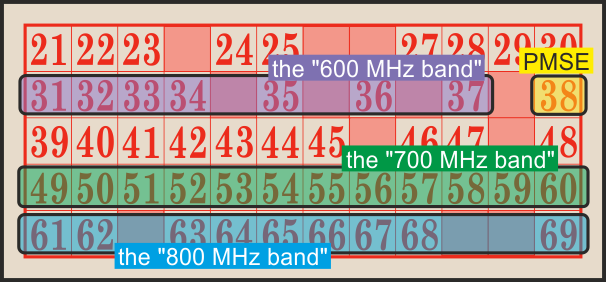Ofcom channel bingo II - introducing the bands
 Brian Butterworth published on UK Free TV
Brian Butterworth published on UK Free TV Following on from Freeview 2020 vs 4G mobile - play Ofcom channel bingo, that discussed the recent history of allocations in the UHF "television band", we now look to the future.
Ofcom, for the purposes of discussion, has named three sets of channels as
- the "600MHz band" - C31 to C37, 554MHz to 602MHz
- the "700MHz band" - C49 to C60, 698MHz to 786MHz
- the "800MHz band" - C61 to C69, 794MHz to 858MHz
As shown on this "bingo card":

800MHz band
Verizon Wireless:The 800MHz band of channels has already been allocated by Ofcom for mobile broadband using the "LTE" (Long Term Evolution) telecommunication standard. This means, of course, that there will be no more Freeview services being provided on these frequencies, and also means, for some homes will have to install free "filters" to stop the 4G transmitters blocking out Freeview - see Ofcom moves to protect Freeview interference from 4G mobile devices - ukfree.tv.However, whilst Ofcom has allocated the frequencies, the actual auction to sell them to telephone companies has been stopped pending legal arguments, so the start date for these services in 2013 may continue to optimisitic.
700MHz band
The channels in the 700MHz band are allocated currently to Freeview services, but the use of these frequencies in the largest 4G market, the USA (for Verizon Wireless and AT&T Mobility) has prompted Ofcom to discuss if these channels could also be used in the UK in the future for 4G.Ofcom has asked Arqiva (see 700 MHz Clearance Planning Options Based on Existing Usage - Study by Arqiva) to see if Freeview could continue to be provided with the removal of the 700MHz band.
At digital switchover, for simplicity to the consumer, transmitters kept the three PSB multiplexes in the "correct" aerial group. This provided for a straightforward switchover, but has required allocation of frequency resources that was not optimal.
The Arqiva planning document looked at three possibilities.
The first is to use the "600MHz band" range for just the three COM Freeview multiplexes using the "extended services" plan (two MFN, one SFN), and to replan all the transmitters so that the 12 channels in the "700MHz band" be deallocated.
The second was to use the initial plan, but to add to it the reuse of some of the gaps in the PSB multiplex plan to extend the COM coverage.
The third plan has the three COM multiplexes recreated on C22, C25 and C28 as SFN (single frequency networks), with the "600MHz band" added to the existing frequencies, minus the "700MHz band" to recreate the PSB three multiplex coverage.
The first plan would keep the PSB coverage, but reduce the COM coverage by 9.6%, 11.6% and 2.5%. The second plan has the same PSB coverage, but 2.5%, 2.5% and 4.2% loss of COMs, and the final one COM loss is 0.9%, 0.6% and 1.3%.
600MHz band
The plans for this band are discussed on the More Freeview capacity - COM7, COM8 and COM9 - in the 600MHz band page.Tomorrow - part three looks at how technological improvements to digital television systems - may provide more with less, see Ofcom Bingo III - compatibility or improvements? - ukfree.tv - independent free digital TV advice.
Help with TV/radio stations?
In this section
Friday, 26 January 2018
MikeP
11:32 PM
11:32 PM
Nev Jack:
Further to that said by MikeB, the government have no say in these frequency changes at all. If you want more bandwidth for mobile signals the transmitter operator has to change the usage of several chennels to free up the frequencies above 700 MHz, meaning many of the TV signals have to be moved to make room for the 4G or future 5G signal usage.
| link to this comment |
Select more comments
Your comment please!